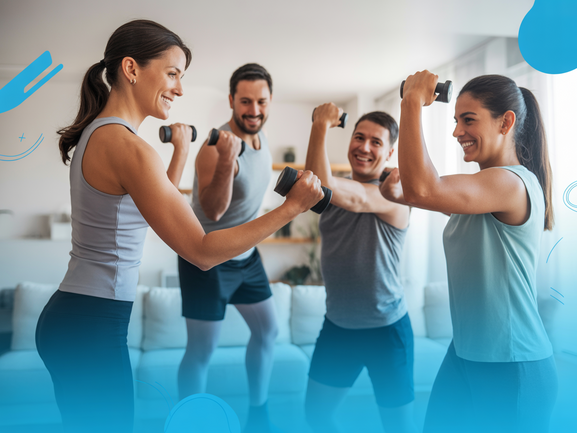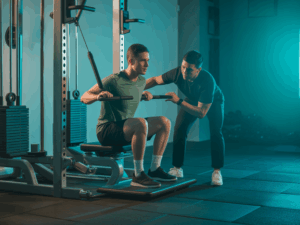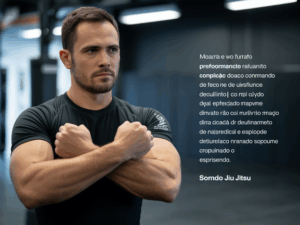How to Build Biceps at Home: A No-Equipment Guide
Building strong, defined biceps is a top fitness goal, but the belief that it requires a gym and heavy weights is a myth. You can achieve impressive arm development right from home. This guide provides a complete roadmap to build biceps at home using only targeted bodyweight exercises, perfect for personal fitness goals and for transformation coaches designing no-equipment programs.
According to a 2025 study in the Journal of Human Kinetics, bodyweight training, when performed with proper form and progressive overload, can stimulate hypertrophy at a level comparable to traditional weightlifting for many muscle groups.
The Science of Muscle Growth Without Weights
To build biceps at home, you must understand hypertrophy (muscle growth). It’s not about lifting heavy; it’s about creating sufficient resistance to challenge muscle fibers, forcing them to repair and grow stronger. You can achieve this with two core principles:
- Mechanical Tension & Time Under Tension (TUT): This is how long your biceps are actively working during a set. Instead of rushing, perform movements slowly and deliberately. For example, taking 5-10 seconds on the lowering (eccentric) phase of an exercise maximizes tension and triggers significant muscle growth.
- Progressive Overload: This is the golden rule of strength training. To continuously build muscle, you must consistently increase the challenge. With bodyweight bicep exercises, you can do this by adding more reps, performing more sets, reducing rest times, or advancing to a more difficult exercise variation.
Why Bodyweight Bicep Exercises Are a Game-Changer
Opting for home-based arm workouts offers a unique set of advantages that make fitness more accessible and sustainable. The convenience of being able to build biceps at home removes common barriers to consistency.
The primary benefits include:
- Cost-Effectiveness: These exercises are completely free. You save on gym memberships and expensive equipment, making fitness accessible to everyone.
- Unmatched Convenience: Perform these workouts anywhere, anytime. This flexibility helps you stay on track, whether you’re at home, traveling, or have just a few spare minutes.
- Reduced Risk of Injury: Bodyweight exercises promote natural movement patterns. This functional approach can lead to a lower risk of injury compared to lifting heavy external loads, especially for beginners.
- Functional Strength: Training with your body weight builds practical, real-world strength that translates directly into daily activities, from carrying groceries to lifting a child.
The 7 Most Effective Exercises to Build Biceps at Home
Here are seven powerful bodyweight bicep exercises that use different forms of resistance to target your biceps. Incorporate these into your routine for visible results and a powerful pump without ever picking up a dumbbell.
-
Negative Chin-Ups (Eccentric Overload)
This is arguably the single best bodyweight bicep builder. The eccentric (lowering) phase is incredibly potent for muscle growth.
Instructions: Use a chair to start at the top of a chin-up position (palms facing you, hands shoulder-width apart). With your chest near the bar, lift your feet off the chair. As slowly and controlled as possible, lower your body until your arms are fully extended. Aim for a 5-10 second descent. Reset and repeat.
Pro-Tip: Focus on squeezing your biceps throughout the entire lowering motion. -
Door Frame Curls (Isometric Contraction)
This exercise uses isometric tension to create a powerful peak contraction.
Instructions: Stand in a doorway and grip the frame with one hand at waist height. Lean your body back until your arm is extended. Keeping your body straight, use only your bicep to pull your torso toward the frame. Squeeze hard for 2-3 seconds at the peak, then slowly return to the start.
Pro-Tip: To increase difficulty, move your feet closer to the doorway. -
Towel Curls (Dynamic Self-Resistance)
A sturdy bath towel is all you need for this dynamic resistance exercise.
Instructions: Sit on the floor with your knees bent. Wrap the towel around your shins and hold the ends with an underhand grip (palms up). While keeping your back straight, initiate a curl with your biceps. Simultaneously, push down with your legs to create opposing resistance. Control the movement on the way up and down.
Pro-Tip: The harder you push with your legs, the more resistance you create for your biceps. -
Self-Resistance Curls (Variable Resistance)
You are the machine here. This exercise allows you to adjust the difficulty in real-time.
Instructions: Make a fist with your right hand (your working arm). Place the palm of your left hand on top of your right fist. As you curl your right fist toward your shoulder, use your left hand to push down, creating constant resistance. Control the movement on both the concentric (up) and eccentric (down) phases.
Pro-Tip: Ensure the resistance is challenging but allows for a full range of motion. -
Floor Curls (Friction Resistance)
This exercise uses floor friction to isolate the biceps effectively, making it an excellent finisher.
Instructions: Lie on your back on a smooth surface (like hardwood or tile) with knees bent and feet flat. Extend your arms to your sides, palms facing up. Isolate your biceps by dragging your hands along the floor toward your shoulders. Squeeze your biceps hard at the top, then slowly slide your hands back to the starting position.
Pro-Tip: Wear socks on your hands to increase the sliding friction and resistance. -
Reverse Bodyweight Curls
This requires a sturdy table or desk. It’s a fantastic way to replicate a classic curl motion.
Instructions: Lie on your back with your upper body under a sturdy table. Grip the edge of the table with both hands, palms facing you. Keeping your body rigid from shoulders to heels, pull your chest towards the underside of the table using your biceps. Pause at the top, then lower yourself slowly.
Pro-Tip: The more horizontal your body, the harder the exercise becomes. -
Band-Assisted Chin-Ups (If you have a band)
While this guide is for no-equipment workouts, a simple resistance band is a cheap and effective tool.
Instructions: Loop a resistance band over your pull-up bar. Place one foot or knee in the loop. The band will assist you in performing a full chin-up, allowing you to complete more reps and focus on form. This is a great way to progress toward unassisted chin-ups.
Pro-Tip: Use different band thicknesses to adjust the level of assistance as you get stronger.
Your Weekly ‘Build Biceps at Home’ Workout Plan
Consistency is key. Aim to train your biceps 2-3 times per week, allowing at least 48 hours of rest between sessions for muscle recovery and growth. Here is a sample routine:
- Negative Chin-Ups: 3 sets of 4-8 reps (focus on a 5-second descent)
- Towel Curls: 3 sets of 8-12 reps (maintain constant tension)
- Door Frame Curls: 3 sets of 10-15 reps per arm (hold the peak contraction)
- Floor Curls: 2 sets to failure (as many reps as possible with good form)
Rest for 60-90 seconds between sets. As you get stronger, apply progressive overload by adding reps, adding a set, or reducing your rest time.
Nutrition for Bicep Growth: Fueling Your Muscles
You can’t out-train a bad diet. To build biceps at home, your nutrition must support muscle repair and growth. Focus on these three areas:
- Sufficient Protein: Protein provides the amino acids necessary to rebuild muscle fibers. Aim for 1.6-2.2 grams of protein per kilogram of body weight daily. Sources include lean meats, eggs, dairy, legumes, and protein supplements.
- Caloric Intake: To build muscle, you generally need to be in a slight caloric surplus (consuming more calories than you burn). This provides the energy needed for intense workouts and recovery.
- Hydration: Water is essential for muscle function and nutrient transport. Drink plenty of water throughout the day to stay hydrated and optimize performance.
For more detailed scientific information on muscle growth, this article from the National Institutes of Health (NIH) is an excellent resource. Additionally, research on eccentric training from institutions like the University of Jyväskylä confirms its effectiveness.
For Transformation Coaches: Scaling Your Business
As a coach, your clients’ results are your best marketing tool. Showcasing transformations achieved with these home exercises builds immense credibility. The Personal Millbody platform is designed for this. It helps you track client progress, manage before-and-after photos, and automate billing for your 30/60/90-day programs.
🎯 Ready to scale your coaching business? Start transforming your career with Personal Millbody and achieve your independence now!
Stop juggling spreadsheets and focus on what you do best: transforming lives. For more industry insights, check out our blog with articles and market data.
Frequently Asked Questions About Home Bicep Workouts
Can you really build big biceps without weights?
Absolutely. Building significant muscle mass is possible by applying principles of progressive overload to bodyweight exercises. To get bigger biceps, you must consistently increase the challenge by adding reps, reducing rest, or using more difficult variations like one-arm negatives. Consistency and proper form are crucial to build biceps at home.
How often should I do bodyweight bicep exercises?
For optimal growth, training biceps 2-3 times per week is recommended. Since these are smaller muscles, they recover relatively quickly. Ensure you allow at least 48 hours of rest between sessions to allow for muscle repair and growth. Listen to your body to avoid overtraining.
How long does it take to see results from home bicep workouts?
With consistent training (2-3 times per week) and proper nutrition, you can expect to see noticeable improvements in bicep definition and strength within 4 to 8 weeks. Significant changes in size and shape typically become more apparent after 3 months of dedicated effort.
What is the single best exercise to build biceps at home?
While there’s no single ‘best’ one, the Negative Chin-Up is exceptionally effective due to its high eccentric load. However, a balanced routine combining various exercises like Towel Curls and Door Frame Curls will always yield superior results by targeting the muscle from multiple angles.
How can Personal Millbody help my fitness coaching business?
Personal Millbody is an all-in-one platform for personal trainers. It allows you to manage clients, track their progress with before-and-after photos, create and sell online fitness programs, and automate your billing. It’s designed to help you scale your business and focus on delivering amazing transformations. Create your account and join the largest platform for personal trainers in Brazil!
💡 Ready to find clients or a personal trainer near you? Find and discover Personal Trainers near you! Or, if you are a potential client, learn more about being a personal training student.
For any questions, feel free to contact us.



